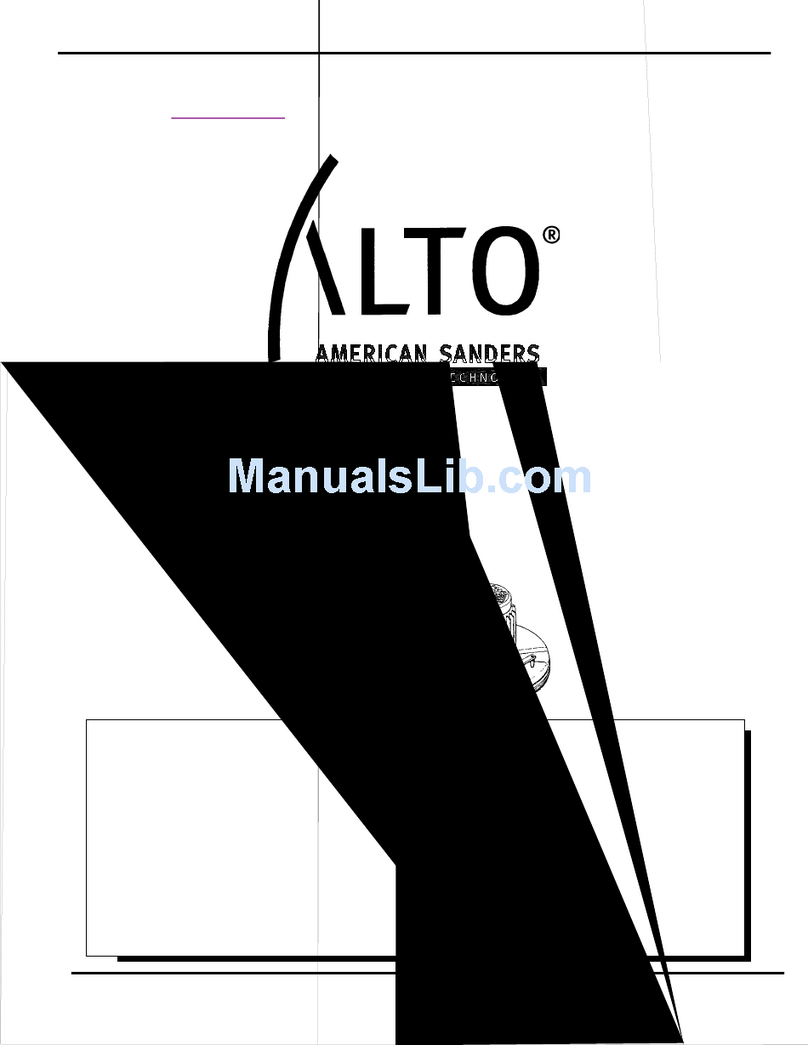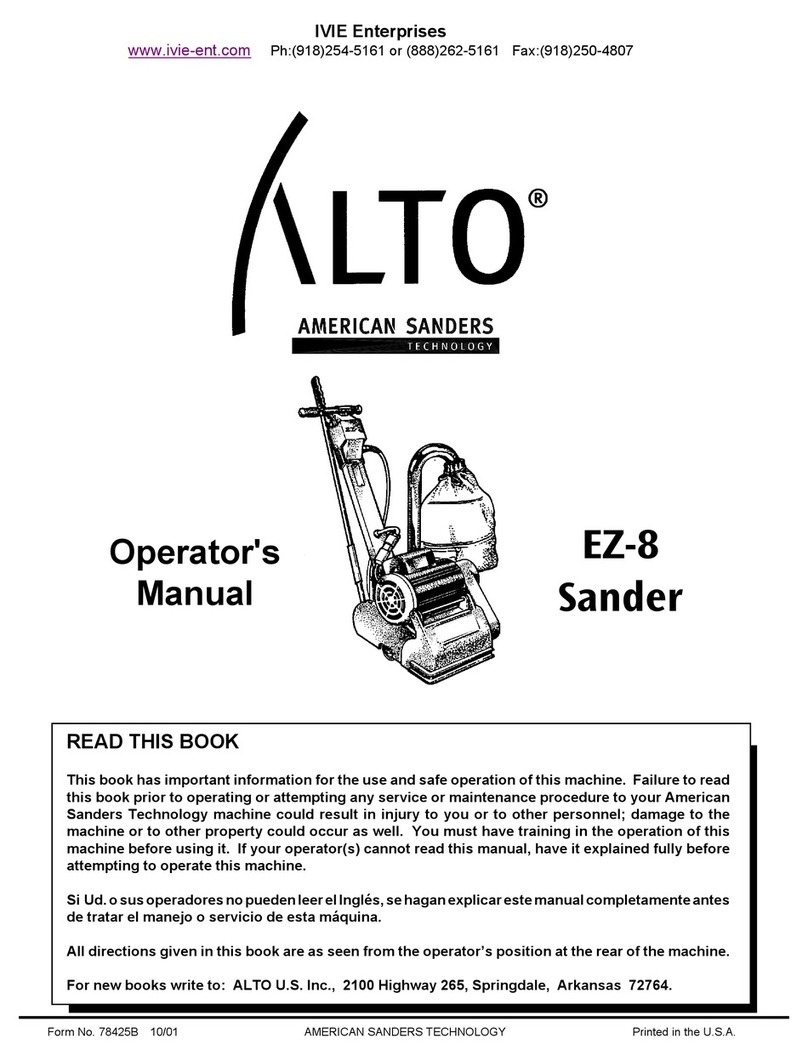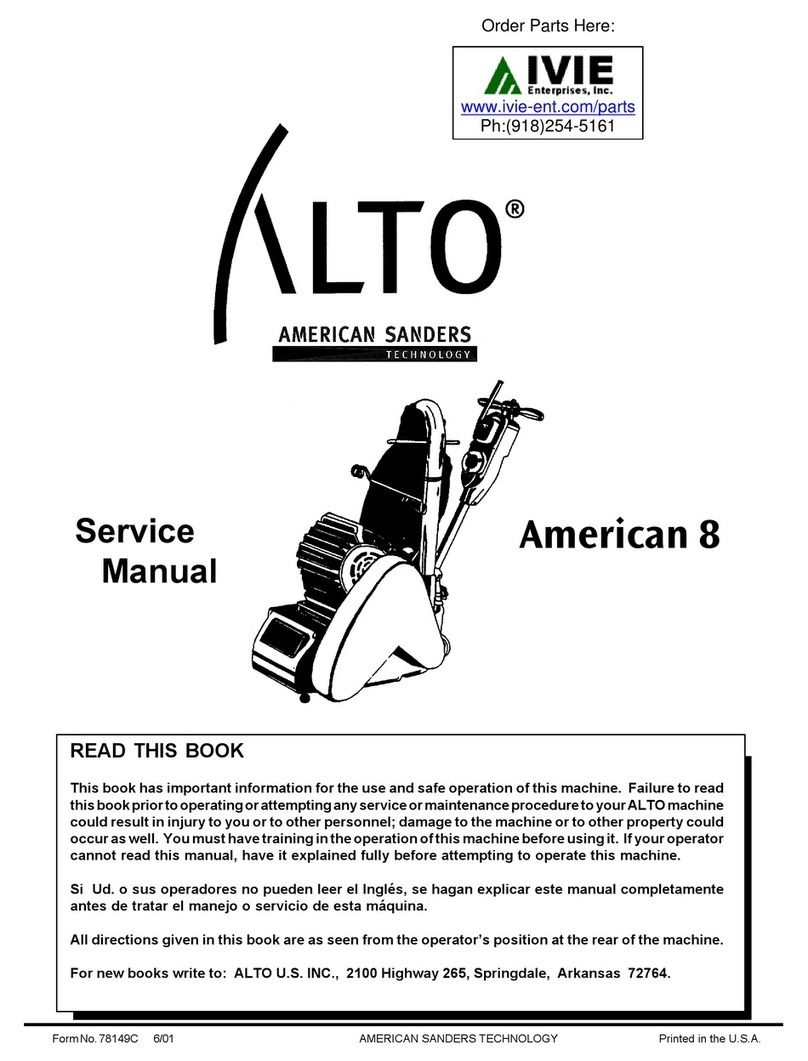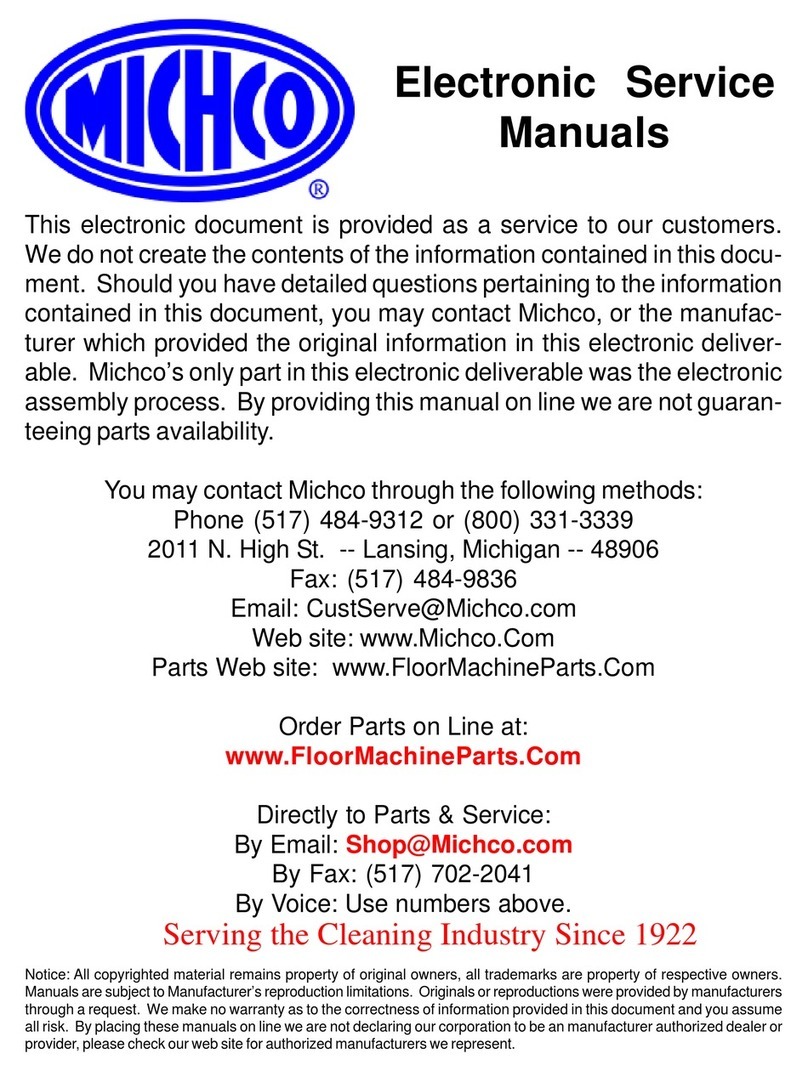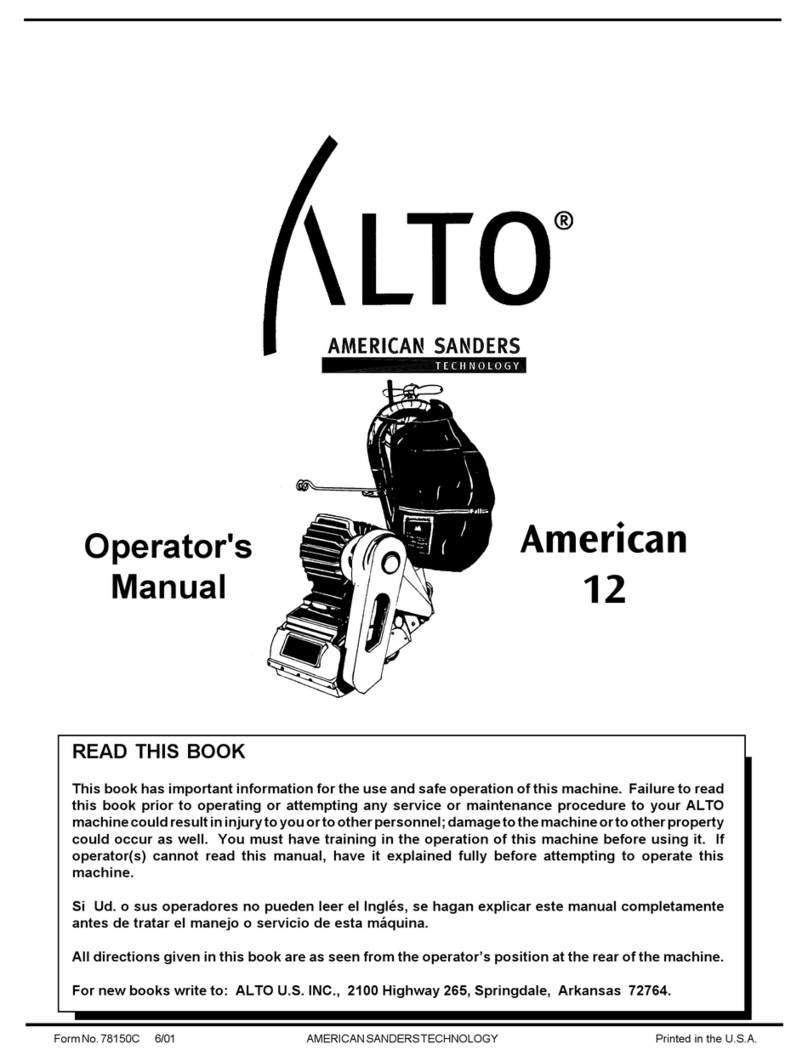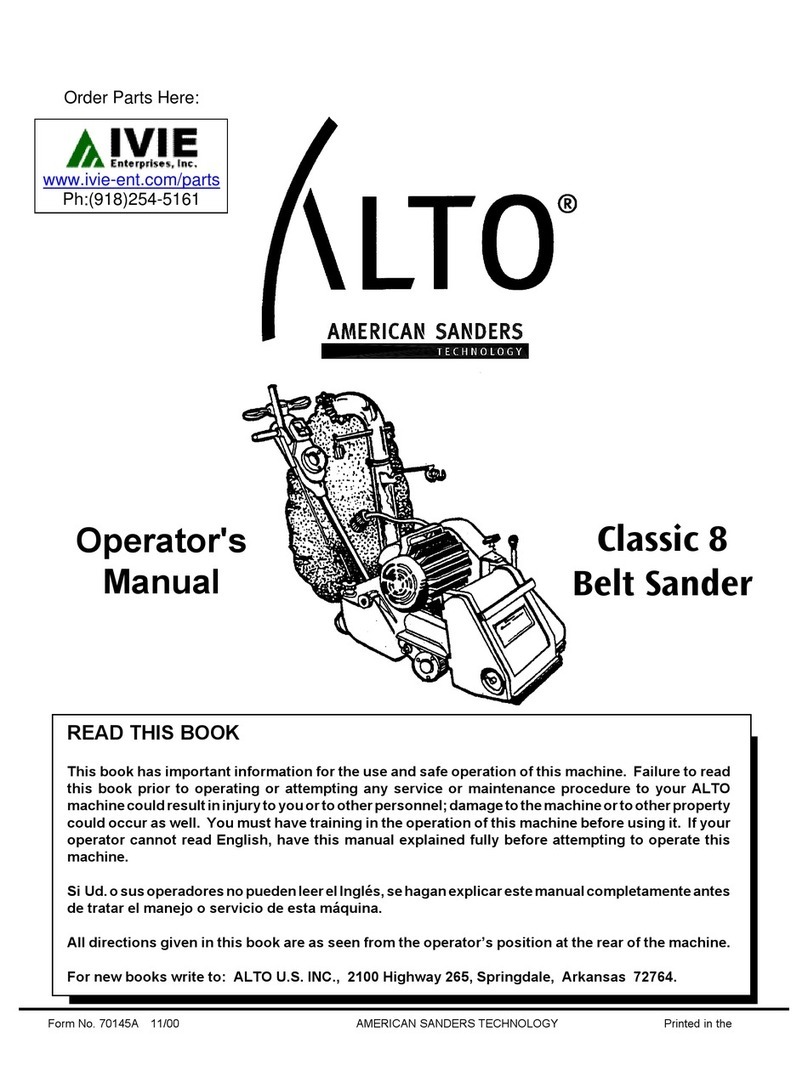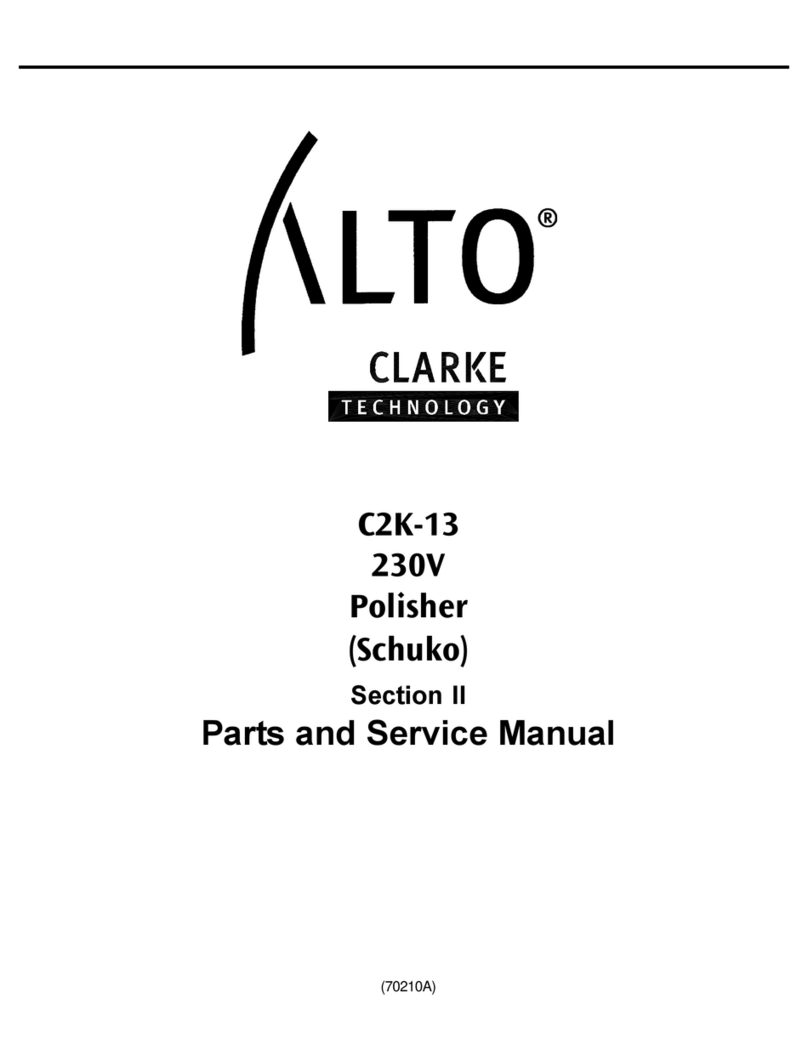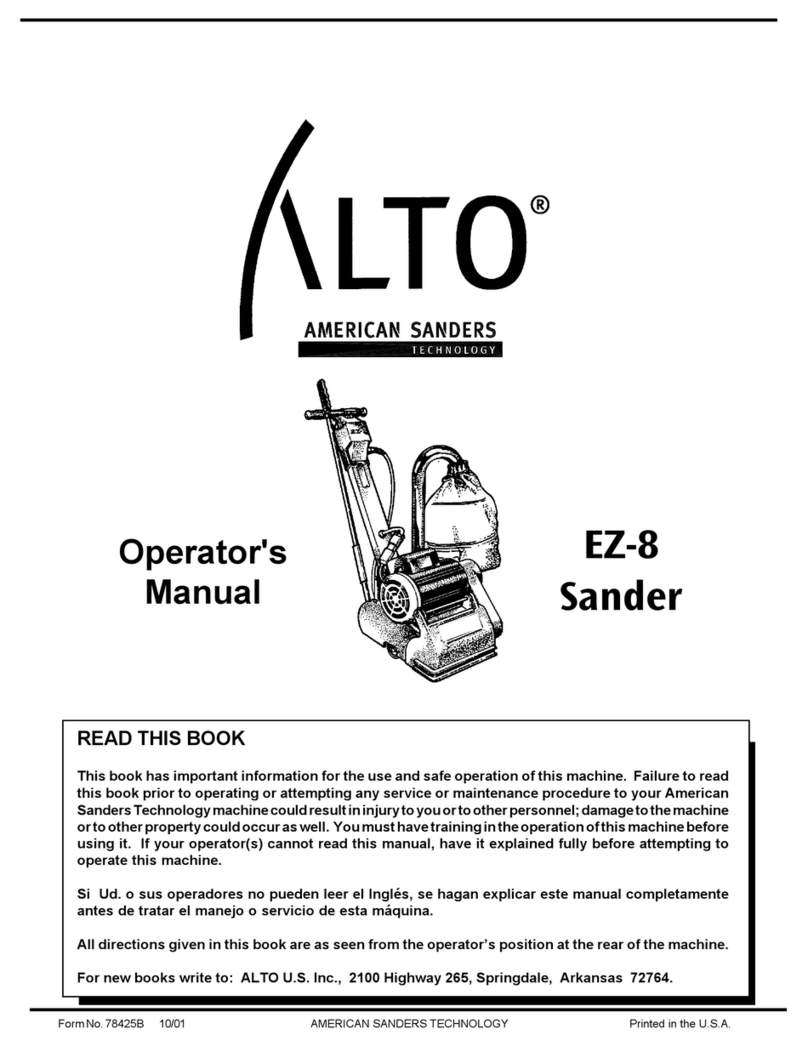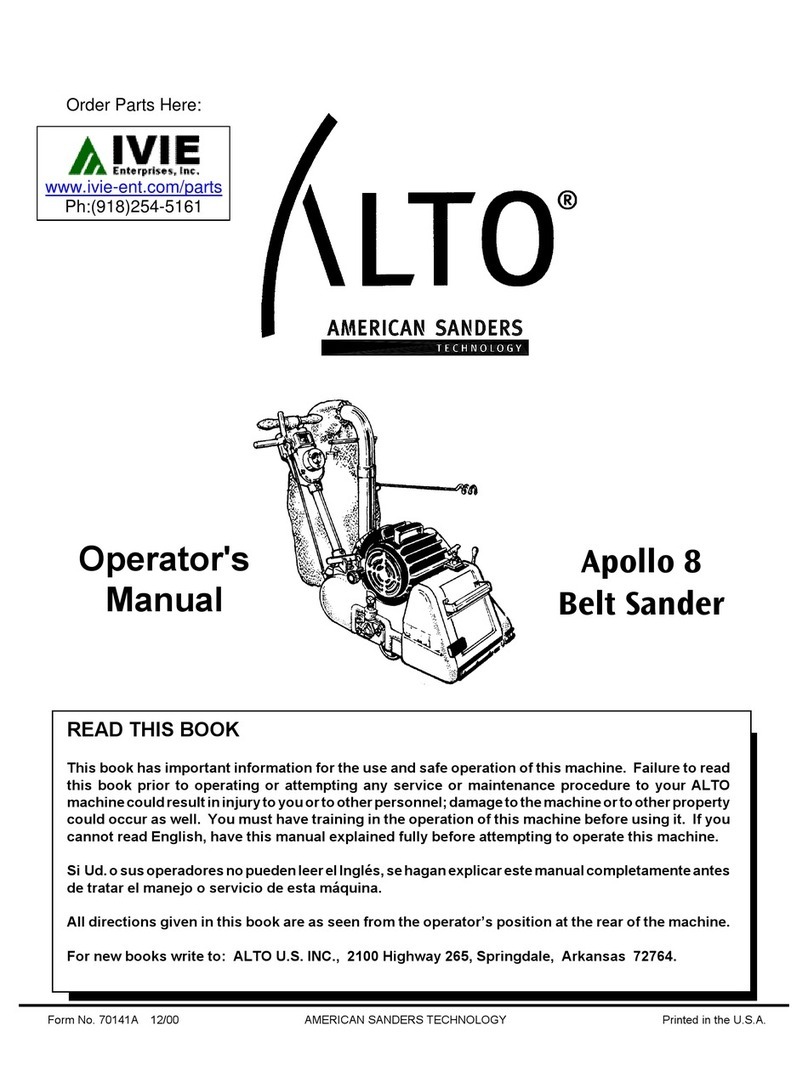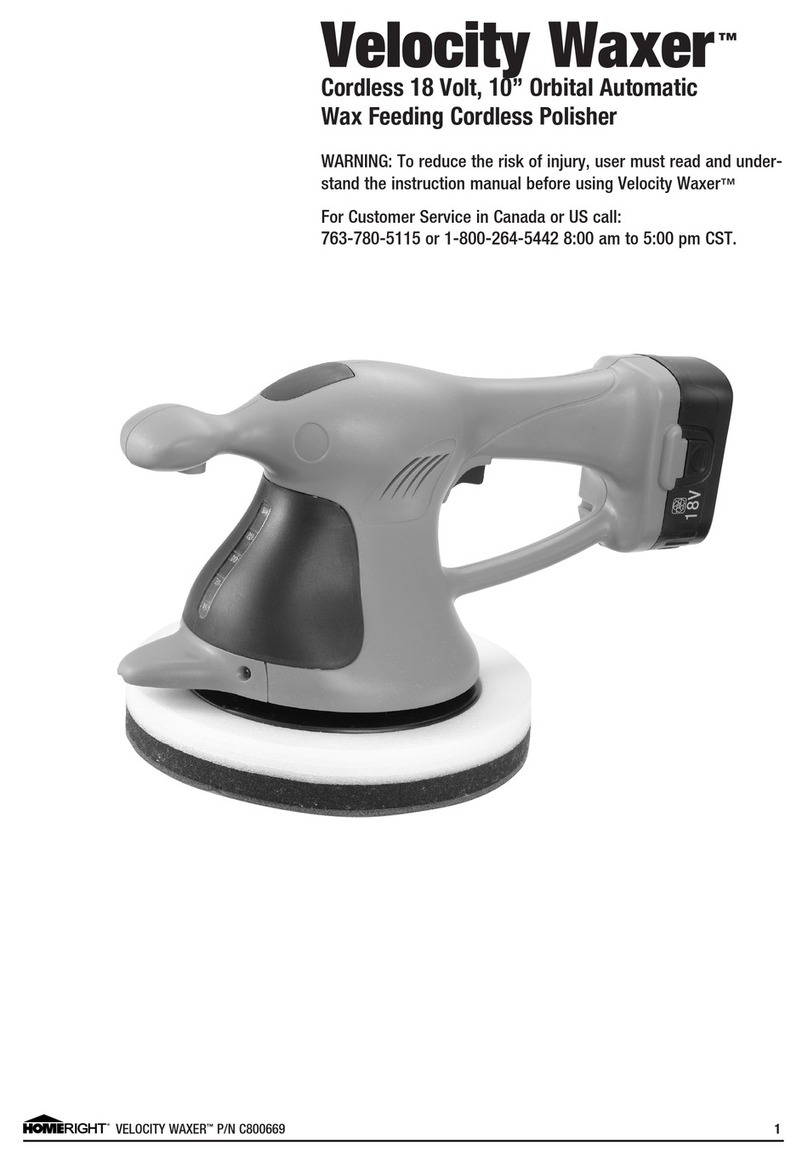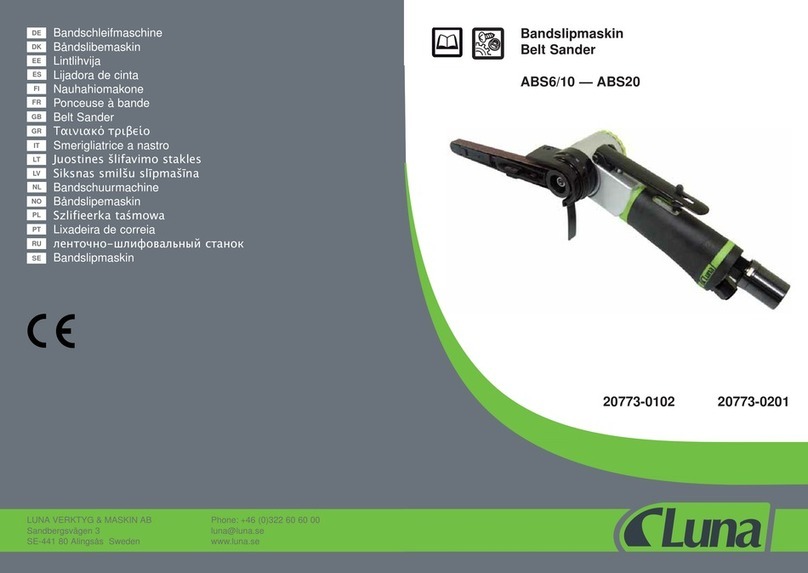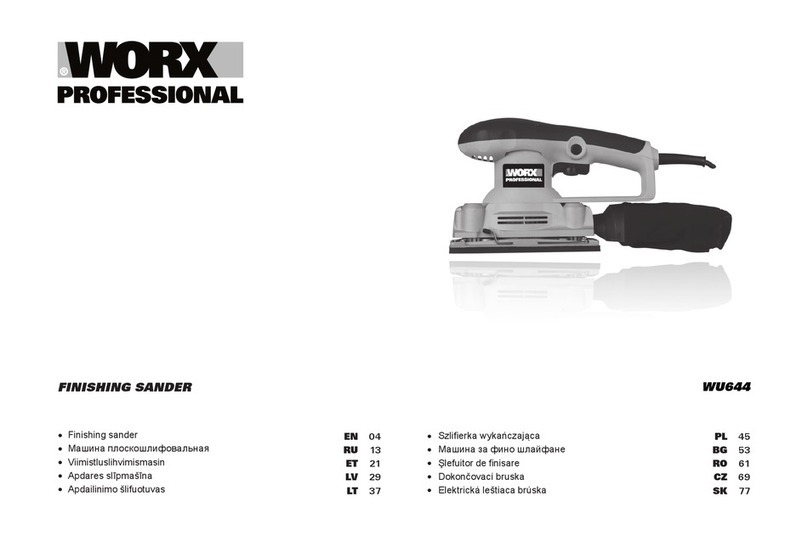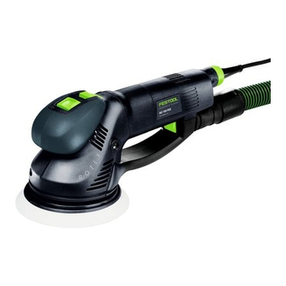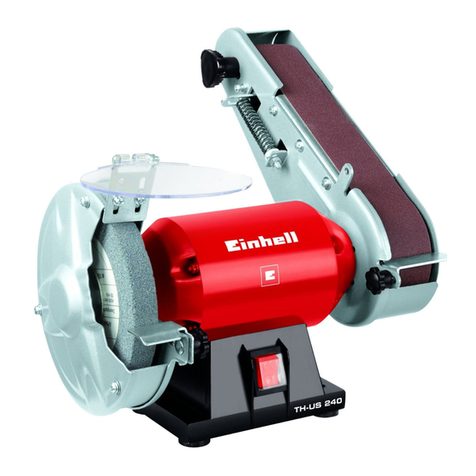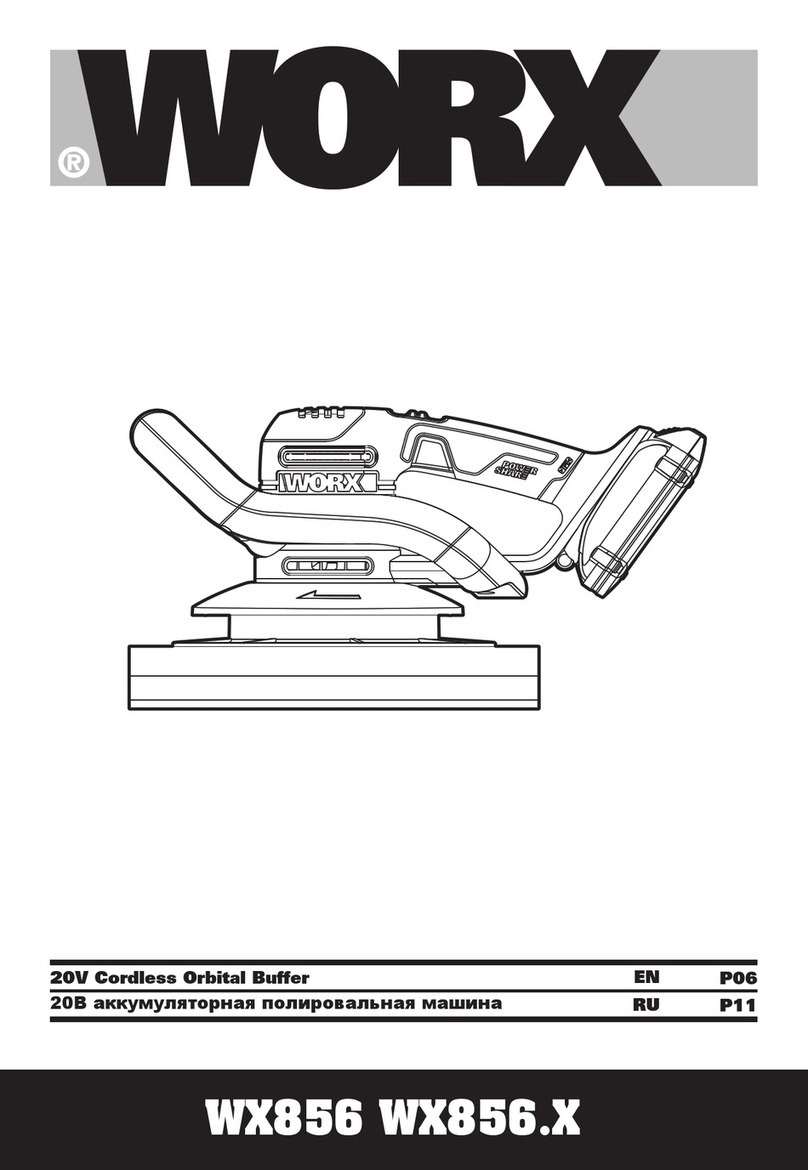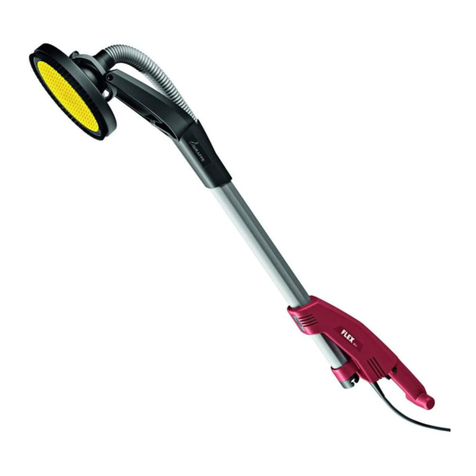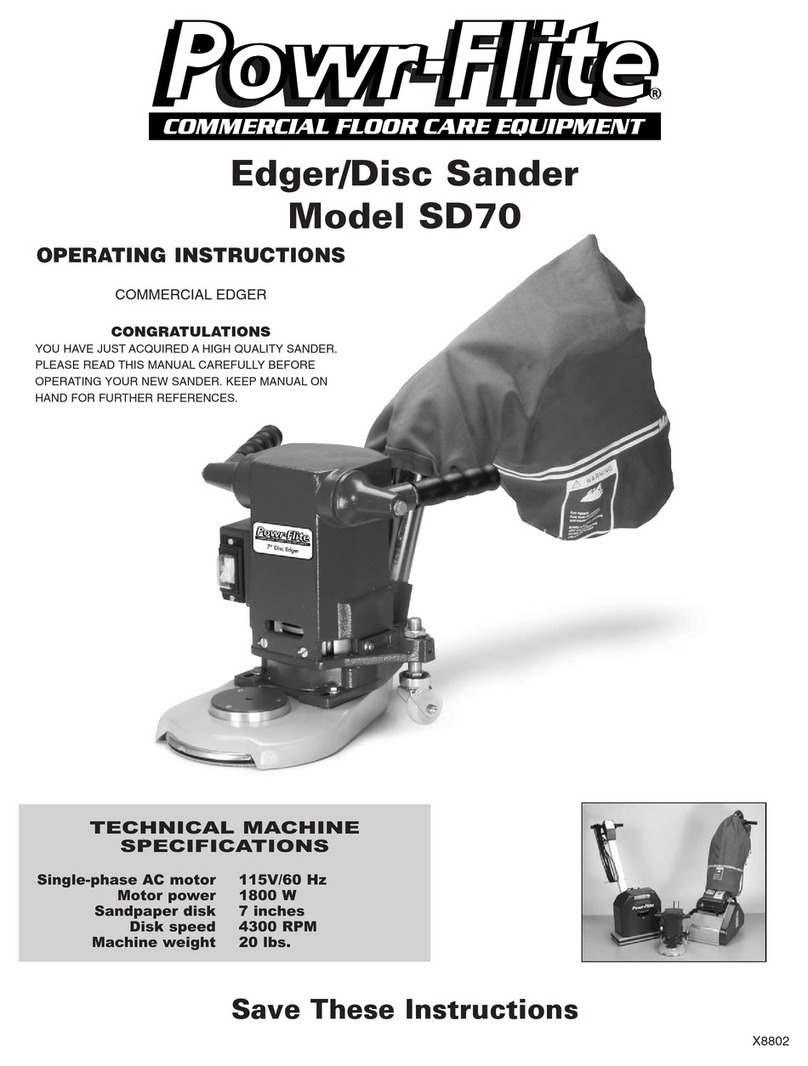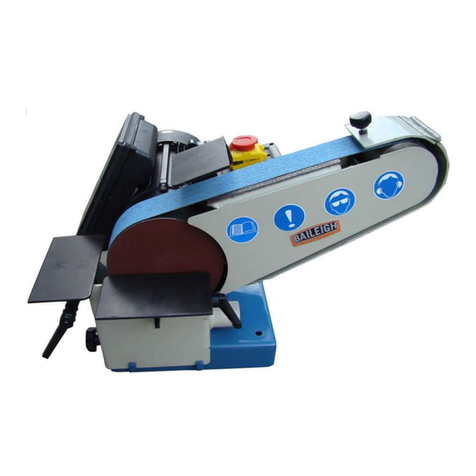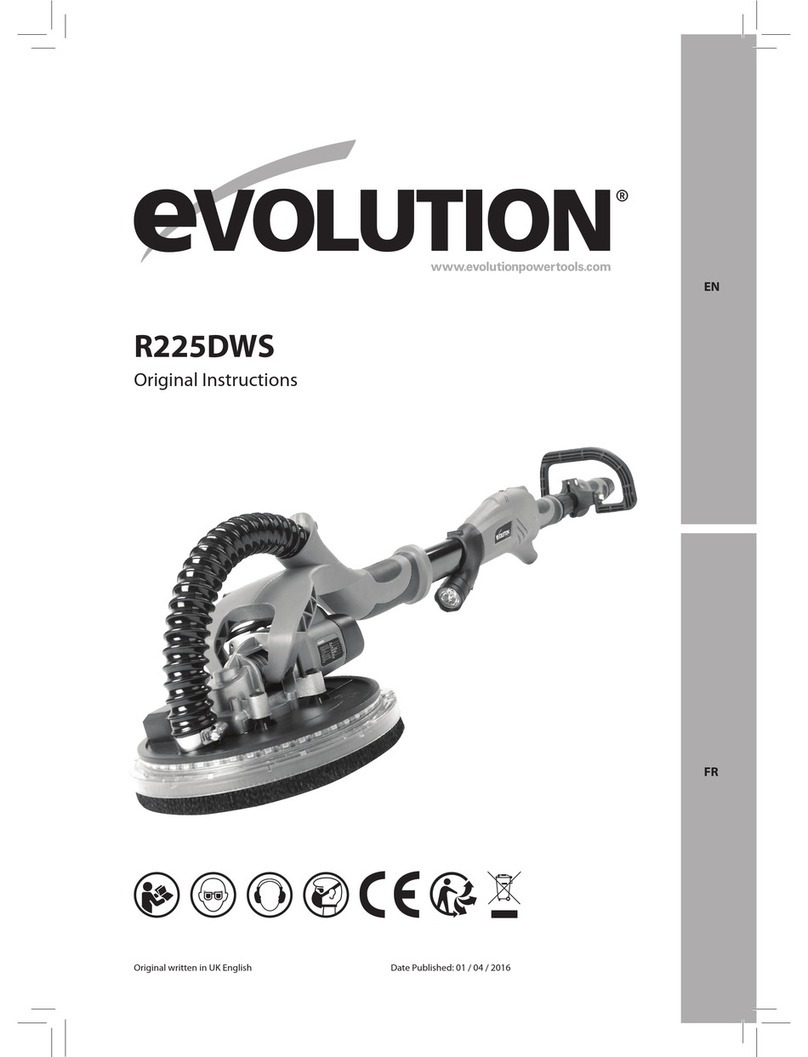Alto Classic 12 User manual

Form No. 70048A 11/00 AMERICAN SANDERS TECHNOLOGY Printed in the
READ THIS BOOK
This book has important information for the use and safe operation of this machine. Failure to read
this book prior to operating or attempting any service or maintenance procedure to your ALTO
machine could result in injury to you or to other personnel; damage to the machine or to other property
could occur as well. You must have training in the operation of this machine before using it. If you
cannot read English, have this manual explained fully before attempting to operate this machine.
Si Ud. o sus operadores no pueden leer el Inglés, se hagan explicar este manual completamente antes
de tratar el manejo o servicio de esta máquina.
All directions given in this book are as seen from the operator’s position at the rear of the machine.
For new books write to: ALTO U.S. INC., 2100 Highway 265, Springdale, Arkansas 72764.
Classic 12
Belt Sander
Operator's
Manual
IVIE Enterprises
www.ivie-ent.com Ph:(918)254-5161 or (888)262-5161 Fax:(918)250-4807

Page 2 AMERICAN SANDERS TECHNOLOGY Classic 12 Belt Sander Operator's Manual
Contents of this Book
Section I - Operator's Manual
OperatorSafetyInstructions .........................................................3
MachineSafetyStatements..........................................................5
IntroductionandMachineSpecifications.......................................6
ElectricalConnectionInstructions .................................................7
HowtoTransporttheMachine ......................................................8
OnePerson ..............................................................................8
TwoPeople ..............................................................................9
MachineSet-Up .........................................................................10
HowtoOperatetheMachine ......................................................11
SandingCuts andSandpaper .................................................. 14
SanderAdjustmentProcedures..................................................15
RoutineMaintenance..................................................................17
Troubleshooting .........................................................................18
Section II - Parts Manual
AssemblyDrawing#1 ................................................................22
Assembly Parts List #1...........................................................23
AssemblyDrawing#2 ................................................................24
Assembly Parts List #2...........................................................25
AssemblyDrawing#3 ................................................................26
AssemblyParts List#3.............................................................27
Wiring Diagram..........................................................................28
IVIE Enterprises
www.ivie-ent.com Ph:(918)254-5161 or (888)262-5161 Fax:(918)250-4807

AMERICAN SANDERS TECHNOLOGY Classic 12 Belt Sander Operator's Manual Page 3
DANGERmeans: Severe bodily injury or death can occur to you or other personnel if the
DANGER statements found on this machine or in this Owner's Manual are
ignored or are not adhered to. Read and observe all DANGER statements
found in this Owner's Manual and on your machine.
WARNINGmeans: Injury can occur to you or to other personnel if the WARNING statements
foundon yourmachineor inthis Owner'sManualare ignoredorare not
adheredto. Readand observeallWARNING statementsfoundin thisOwner's
Manualandonyourmachine.
CAUTIONmeans: Damage can occur to the machine or to other property if the CAUTION state-
mentsfound onyour machineor inthis Owner'sManual areignored orare not
adheredto. Readandobserve allCAUTION statements foundinthis Owner's
Manualandonyourmachine.
DANGER: Failuretoread theOwner's Manualpriortooperatingorattemptingany serviceor mainte-
nance procedure to your American Sanders Technology machine could result in injury to
you or to other personnel; damage to the machine or to other property could occur as
well. You must have training in the operation of this machine before using it. If you
cannot read English, have this manual explained fully before attempting to operate
thismachine.
DANGER: Sanding/finishingwoodfloorscancreateanenvironmentthatcanbeexplosive. The
followingsafetyproceduresmustbeadheredto:
• Cigarettes, cigars, pipes, lighters, pilot lights and any other source of ignition can create
an explosion when active during a sanding session. All sources of ignition should be
extinguishedorremovedentirelyfromtheworkarea.
• Workareasthatarepoorlyventilatedcancreateanexplosiveenvironmentwhencertain
combustible materials are in the atmosphere, i.e., solvents, thinners, alcohol, fuels,
certain finishes, wood dust and other combustible materials. Floor sanding machines
cancauseflammablematerial andvaporstoburn. Readthe manufacturer'slabel onall
chemicals used to determine combustibility. Keep the work area well ventilated.
• Spontaneouscombustion oran explosioncan occurwhen workingwith sandingdust.
The sanding dust can ignite and cause injury or damage. Sanding dust should be
disposed of properly. Always empty the sanding dust into a metal container that is
locatedoutside ofany building.
• Remove the contents of the dust bag when the bag is 1/3 full. Remove the contents of
the dust bag each time you finish using the machine. Never leave a dust bag unattended
with sanding dust in it.
• Do not empty the contents of the dust bag into a fire.
• Hitting a nail while sanding can cause sparks and create an explosion or fire. Always
countersinkallnailsbeforesandingfloors.
DANGER: Operating a machine that is not completely or fully assembled could result in injury or
property damage. Do not operate this machine until it is completely assembled. Keep
all fasteners tight. Keep adjustments according to machine specifications.
DANGER: Electrocution could occur if the machine is used on a power circuit that repeatedly trips or is
undersized. Have a licensed electrician check the fuse, circuit breaker or power supply.
WARNING AVERTISSEMENT ADVERTENCIA
OPERATOR SAFETY INSTRUCTIONS

Page 4 AMERICAN SANDERS TECHNOLOGY Classic 12 Belt Sander Operator's Manual
DANGER: Electrocutioncouldoccurifmaintenanceandrepairsareperformedonaunitthatisnotproperly
disconnected from the power source. Disconnect the power supply before attempting any
maintenanceorservice.
DANGER: Electrocution could occur if machine is used on ungrounded electrical circuit. Never remove
or disable the grounding supply conductor on the electrical cord. Consult an electrician if the
grounding conductor is missing or if you suspect your circuit is not grounded properly.
DANGER: Use of this machine with a damaged power cord could result in an electrical shock. Do not
use the machine if the power cord is damaged. Do not use the electrical cord to move the
machine.
DANGER: Electrocution or injury could occur if the power cord is run over or damaged by the sander.
Keep the cord free from under the machine to avoid contact with the sandpaper. Always lift
the power cord over the machine.
DANGER: Moving parts of this machine can cause serious injury and/or damage. Keep hands, feet and
loose clothing away from all moving parts of the sander.
DANGER: Operating a sander without all guards, doors or covers in place can cause an injury or damage.
Always check to make sure that all of the guards, doors and covers are secure and in place.
DANGER: Injury to the operator or bystanders could occur if the machine's power is on while performing
maintenance, changing or adjusting the belt, or changing the dust bag.
DANGER: Attempting to adjust the belt tracking while the machine is on can cause injury and/or damage.
Do not perform belt tracking adjustments while the machine is running.
WARNING: Failure to read and observe all safety statements found on your machine or in this Owner's
Manual can result in serious injury or damage. Read and observe all safety statements. Make
sure that all labels, decals, warnings, cautions, and instructions are fastened to the machine.
GetnewlabelsfromyourauthorizedAmericanSandersTechnologydistributor.
WARNING: Sanding dust can be airborne and can be breathed in while operating a sander. Always wear
a dust mask while operating sanding equipment.
WARNING: Injury to the eyes and/or body can occur if protective clothing and/or equipment is not worn
while sanding. Always wear safety goggles, protective clothing, and a dust mask while
performing any sanding operation.
WARNING: Bodily injury could occur if power is applied to the machine with the power switch already in
the "ON" position. Always check to assure that the power switch is in the "OFF" position
before applying power to the power cable.
CAUTION: Maintenance and repairs performed by unauthorized personnel could result in damage or
injury. Maintenance and repairs performed by unauthorized personnel will void your warranty.
Servicing of this unit must always be referred to an authorized American Sanders Technology
distributor.
CAUTION: Use of this machine to move other objects or to climb on could result in injury or damage. Do
not use this machine as a step or furniture. Do not ride on this machine.
CAUTION: Damage could occur to the machine if not properly kept in a dry building for storage. Store
the machine in a dry building.
CAUTION: The machine is heavy. When transporting the machine, remove the motor. Get help to lift
the machine and motor.
CAUTION: Serious damage to the floor can occur if the machine is left running in one spot while the
sandingdrumisin contact withthefloor. To avoid damage tothefloor, feather cutinat a normal
sanding rate. Do not dwell while lowering or raising the contact wheel. Always sand at a
constant rate.

AMERICAN SANDERS TECHNOLOGY Classic 12 Belt Sander Operator's Manual Page 5
The following safety decals are mounted on the machine as shown. If these or any other machine decal, label
or plate should become damaged or illegible, install a new decal in its place. Contact your local authorized
distributorfornewdecals.
Thefollowinginformationsignalspotentiallydangerousconditionstotheoperatorand/orequipment. Readthis
manual carefully and familiarize yourself with the machine. Know when these conditions can exist. Locate all
safety devices on the machine. Then, take the necessary steps to train the personnel that will be operating
themachine. Report machinedamage orfaultyoperation immediately.
1. Keep hands and clothing clear of rotating parts.
2. Keep hands on controls with the motor running.
3. Donotleavethe machinewith themotorrunning.
4. Do not operate the machine with the access door or the belt guard open.
5. Always operate the machine with the dust bag in place.
6. Donot removethe dustbagwiththemotorrunning.
7. Alwaysdisconnect themotor pigtailpower cordfrom thehandle beforeservicingthemachine.
8. Usecaution whentransporting.Themotor weighs120 lbs.The machineweighs157lbs.
9. Alwaysoperate inawell ventilatedarea.
10. Always dispose of sanding dust properly.
Machine Safety Statements

Page 6 AMERICAN SANDERS TECHNOLOGY Classic 12 Belt Sander Operator's Manual
Introduction and Machine Specifications
PARTNUMBER 07055C 07056C
ABRASIVEBELTSIZE 11-7/8" W x 31-1/2" L 30cmX 80cm
CONTACTWHEELSPEED(RPM) 2850 2375
ABRASIVESPEED 5262sfm(surfacefeetperminute) 22m/second
DUSTFANSPEED(RPM) 6800 5667
DUST FAN FLOW 234cfm(cubic feetper minute) 110liters/second
MOTOR(07055A) 4hp230V60Hz 2.2kW 230V 50Hz
LEVELINGCONTROL Externallyadjustable
OPERATINGCONTROL Adjustablelever/grip
MOTORSTARTER/PROTECTOR Magneticcircuitbreaker
SANDINGPRESSUREADJUSTMENT Infinitelyadjustable
WHEELS Replaceable3½"O.D. 89mm
BEARINGS Radialball,permanentlylubricated
DIMENSIONS 37"H x 18½"W x 35"L 94cm x 47cm x 89cm
WEIGHT 277 lbs. (300 lbs. with cord) 126kg (136kgwith cord)
CAUTION: Your equipment may be inappropriate on some installations. Some softer
woods used in flooring cannot support the pressure created by hard wheels.
A felt or rubber wheel should be used when these woods are encountered.
See parts list for optional wheels.
Always consult with the flooring manufacturer on the proper installation,
preparation, and finishing of their product. Determine suitability of your
equipment in preparing the product.
Operating Control Lever
Motor Starter / Protector
Tension Release Lever
Sanding Pressure Adjustment
LevelAdjustment Nut
IVIE Enterprises
www.ivie-ent.com Ph:(918)254-5161 or (888)262-5161 Fax:(918)250-4807

AMERICAN SANDERS TECHNOLOGY Classic 12 Belt Sander Operator's Manual Page 7
Electrical Connection Instructions
CAUTION: This machine will operate only on AC frequency and voltage shown on the motor
nameplate. Makesureyouhavethecorrectfrequencyandvoltagebeforeconnectingthe
power cord to an outlet. The machine has a plug as shown below.
Note:Europeanmachinesare notequippedwithanelectricalplug.
Thismachinemustbeconnectedtoanelectricallygroundcircuitinordertoprotecttheoperatorfromelectricshock.
Thismachinehasanapprovedpowercordwiththreeconductorsaswellasaplugwiththreeterminals. Connectthe
plug into a three holed receptacle. For maximum protection against electric shock, use a circuit that is protected
bya groundfaultcircuit interrupter.
DANGER: Electrocution could occur if the machine is exposed to water or rain. Keep the machine
in a dry building.
DANGER: Electrocutioncouldoccurifmachineisimproperlyconnectedtotheelectricalsystem. To
prevent possible electric shock, always use a 3-wire electrical system connected to an
electrical ground. For maximum protection against electrical shock, use a circuit that
is protected by a ground fault circuit interrupter. Consult your electrical contractor.
DANGER: Electrocution could occur if the ground pin is tampered with in any way. Do not cut,
remove, or break the ground pin. Do not try to fit a three-terminal plug into a receptacle
or connector body other than a three holed receptacle or connector body matching the
machine plug. If the outlet does not fit the plug, consult your electrical contractor.
DANGER: Electrocution could occur if the machine is used with a damaged plug or power cord. If
thecordsorplugsareworn ordamagedinanyway,havethemreplacedbyanauthorized
service person or electrician.
ExtensionCords
Useonly anapproved three-prongedextension cordwith twomain conductorsand oneearthing conductor. This
machine’spowercordhasawiresizeof10gauge. Thismachineisequippedwitha100'power cord. Whengreater
rangeisneededfollowthetablebelowtodeterminewireguageofadditionalfootage. Refertothefollowingchart
forextensioncordinformation.
If motor appears to labor or takes a considerably longer time to come up to speed, reduce sanding pressure.
Figure 1
Feet/Wire Guage (Stranded Copper)
208 6
230 10 8
Source Voltage 0 - 100' 100 - 250'
Use Voltage
Booster

Page 8 AMERICAN SANDERS TECHNOLOGY Classic 12 Belt Sander Operator's Manual
How to Transport the Machine
WARNING:The machine is heavy. Remove
themotor fromthemachinebefore
transporting. Get help loading the
machine and motor.
Transporting the Machine - One Person
Totransportthemachine,followthisprocedure:
1. Make sure the power cable is disconnected from
the electrical outlet.
2. Disconnectthe handlepigtail cord connection.
(twist and pull) See figure 2.
3. Loosenthe belttension T-screwcompletely.
4. Graspthebeltguardimmediatelyabovetheleft
hand truck wheel and pull to gain access to the
drivebelts. Removethedrivebelts.
Seefigure3.
5. Unscrewthe motormountingknob clearof the
counterbore on chassis. See figure 4.
6. Straddle the machine. With your legs, lift the motor
off of the chassis. Take the motor to worksite.
7. Lift the chassis by grasping the front and rear
handle. Bring the belt guard against your chest.
Take the chassis to worksite.
Toassemble themachineafter transporting,followthis
procedure:
1. Openthebelt guarddoor.
2. Place the motor assembly on the chassis.
3. Screw in the motor mounting knob completely.
Seefigure4.
4. Installthedrivebelts.
5. Tighten the belt tension T-screw only until the
contact drive wheel belt does not squeal upon start
up. Do not over tighten.
CAUTION: Premature bearing failure can oc-
cur if the belt tension is set too
tight. The fan drive belt should
deflect½" at thecenter ofthe span
with 5 lbs. of pressure.
Figure2
Figure3
Figure4

AMERICAN SANDERS TECHNOLOGY Classic 12 Belt Sander Operator's Manual Page 9
NOTE: It is not always necessary to adjust the fan
beltindependentlyduringthisprocedureorduring
replacement.
NOTE: New drive belts may shed particles of rubber
until seated to the pulley grooves. This seating
process can take up to 24 hours to accomplish.
6. Closethe beltguard door.
7. Plug the motor pigtail in. Twist clockwise to lock.
Transporting the Machine - Two People
Whentransportingthemachinewithtwopeoplefollow
thisprocedure:
1. Oneoperatorplaceshands underthefrontofthe
machinemaincasting.
2. Person #2 lifts the machine by the handle.
IVIE Enterprises
www.ivie-ent.com Ph:(918)254-5161 or (888)262-5161 Fax:(918)250-4807

Page 10 AMERICAN SANDERS TECHNOLOGY Classic 12 Belt Sander Operator's Manual
Machine Set-Up
Toset-upyourmachinefollowthisprocedure:
1. Familiarizeyourself withthe machineand readall
danger,warningand cautionstatements. Make
sureall operatorsofthismachinehavereadthis
Owner's Manual. If they cannot read English,
havethemanualexplainedfullybeforeallowing
anyonetooperate thesander.
2. Locatethe powersupply. The receptacleshould
be compatible with the plug. The receptacle must
begroundedand mustbefused(30amp) toavoid
anelectricalhazard.
3. Clip the dust bag to the elbow. See figure 5.
Cross the strings on the dust bag and draw tight
over the flare on the elbow. Wrap the string
aroundtheelbowandsecure.
4. Wind the power cord through the cable arm. See
figure 6. Keep the power cord out of path of
equipment.
5. Pull the draw latch forward to release the access
door to gain entry to the sanding chamber.
6. Rotatethereleaseleverforward. Seefigure7.
7. Installanew abrasivebelt byslidingtheabrasive
over the tension roller and contact wheel. See
figure8. See tableon page12 forabrasive belt
selection.
8. Rotate the release lever clockwise to tighten the
abrasivebelt.
9. Plugthe pig-tailedpower cordintothehandle.
Twist the cord connection clockwise to lock.
10. Turn onthemotor circuitbreaker (switch)momen-
tarily.
11. Observe thebelttracking. Followthe procedures
outlinedin the"SanderAdjustmentProcedures"
on page 14 to correct the belt tracking. There is
also a label on the inside of the access door that
outlines the belt tracking adjustment.
12. Close the access door. Place the end of the draw
latch over the keeper on the access door and
push the draw latch flat against the mainframe to
secure. Figure8
Figure5
Figure6
Figure7
IVIE Enterprises
www.ivie-ent.com Ph:(918)254-5161 or (888)262-5161 Fax:(918)250-4807

AMERICAN SANDERS TECHNOLOGY Classic 12 Belt Sander Operator's Manual Page 11
How to Operate the Machine
DANGER: Sanding/finishing wood floors
can create an environment that
can be explosive. Cigarettes,
cigars, pipes, lighters, pilot
lights and any other source of
ignition can create an explosion
when active during a sanding
session. Allsources of ignition
should be extinguished or
removed entirely from the work
area.
DANGER: Work areas that are poorly
ventilated can create an explo-
sive environment when certain
combustible materials are in the
atmosphere, i.e., solvents,
thinners, alcohol, fuels, certain
finishes, wood dust and other
combustible materials. Floor
sanding machines can cause
flammable material and vapors
to ignite. Read the manufac-
turer's label on all chemicals
used to determine combustibil-
ity. Keep the work area well
ventilated.
DANGER: Sandingdust can spontaneously
ignite and cause an injury or
damage. Sanding dust should
be disposed of properly. Always
empty the sanding dust into a
metal container. Remove the
contents of the dust bag when
the bag is 1/3 full.
DANGER: Sandingdust can spontaneously
ignite and cause an injury or
damage. Remove the contents
of the dust bag each time you
finish using the machine.
Always dispose of the dust in a
metal container located outside
of the building. Never leave a
dust bag unattended with
sanding dust in it. Do not empty
the contents of the dust bag into
a fire.
DANGER: Hitting a nail while sanding can
cause sparks and create an
explosion or fire. Always
countersink all nails before
sandingfloors.
IVIE Enterprises
www.ivie-ent.com Ph:(918)254-5161 or (888)262-5161 Fax:(918)250-4807

Page 12 AMERICAN SANDERS TECHNOLOGY Classic 12 Belt Sander Operator's Manual
Figure9
Tooperatethemachinefollowthisprocedure:
1. Installthe operator'sbeltas follows:
a. Positionthe operator'sbelt aroundwaist.
b. Cross the straps at the waist. See figure 9.
c. Slide the belt loop end over the handle on the
control lever side. Adjust the length as needed.
d. Wraptheremainingstrap aroundthe opposite
side of the handle and hold it in place with your
hand.
WARNING: Serious operator injury could oc-
cur if the operator has tied the
loose end of the operator's belt
straptothemachine. Alwaysposi-
tionthestrap so that youcan let go
andgetawayquicklyincaseofbag
fire or explosion.
2. Put the On/Off switch into the "ON" position.
DANGER: Serious damage can occur to the
floorsurfaceifthemachineisnotin
motion while the contact wheel is
running on the floor surface. To
prevent damage to the surface,
make sure the machine is always
moving when the contact wheel is
in contact with the floor.
3. Work right to left. For each forward pass, move the
machine6"over thepass youhave justfinished.
Retraceyourreversepathwithoutoverlapping. See
figures10Athrough10E.
4. Feather-cutby easingthe contactwheeldown onto
thesurfacewith thecontrol leverwhile the sanderis
in motion.
5. When contact wheel is fully engaged with the
surface,graduallyadjustyourpaceforadequate
finishremoval. Keep sanderin motionwhile the
contact wheel is on the floor surface or dwell marks
will occur.
6. Move the machine in the direction of the grain in the
wood whenever it is possible. Sand the surface at a
constant pace.
7. Graduallyfeather-cuttheterminationpoint(theend
of your pass) by easing the contact wheel up with
thecontrol lever. Staggerthetermination pointsfor
abetterblendwhenedging.
8. Emptydust bagwheneverit is1/3 full. Never leave
a dust bag unattended with sanding dust in it.
Sanding dust can spontaneously ignite and cause a
fire or explosion. Empty dust into a metal container
located outside of the building.
IVIE Enterprises
www.ivie-ent.com Ph:(918)254-5161 or (888)262-5161 Fax:(918)250-4807

AMERICAN SANDERS TECHNOLOGY Classic 12 Belt Sander Operator's Manual Page 13
A. First pass forward, right to left.
C. Second pass forward, overlap ½ the drum width. D. Second pass reverse, retrace
second path forward, etc.....for the entire room.
B. First pass reverse, retrace same path.
E. Work the remaining unsanded floor in the
same fashion, right to left.
Figure 10, A - E

Page 14 AMERICAN SANDERS TECHNOLOGY Classic 12 Belt Sander Operator's Manual
InitialCut
The purpose of the initial cut is to remove old finish and gross imperfections on the floor surface. The sanding
equipmentshouldbeadjustedto heavysanding pressuresetting anda coarseabrasive beltshould beused. If
the surface is severely damaged by deep scratches, pre-existing dwell marks, uneven planks, etc., it may be
necessary to sand across or diagonally to the grain to restore evenness to the surface. If these conditions are
not present, the initial cut should be done in the direction of the grain.
If glazing, loading, or burning takes place immediately into an initial cut, select a coarser abrasive. If this
should occur during an initial cut, the abrasive has dulled and must be replaced.
Finishing Cuts
The purpose of a finishing cut is to remove the scratches produced during the initial cut. Use a fine (60 - 80
grit)abrasiveandareducedsandingpressuresetting.
If the surface remains rough after a finishing cut, it may be necessary to use an even finer grit of abrasive (80 -
100 grit). Care should be taken in selecting the grit size of the abrasive. A very fine grit will close the pores
of the wood. If the pores of the wood are closed it will not accept stain.
If glazing or burning should occur immediately into a finishing cut, reduce the sanding pressure and/or select
a coarser abrasive. If it should occur during a finishing cut, the abrasive has dulled and must be replaced.
Sanding Cuts and Sandpaper
Aluminum Silicon Ceramic
Grit Use Oxide Carbide Alum. Oxide
AbrasiveBelts
Note: All part numbers listed are for a carton of 10 belts
Forremovinggrossimperfectionsandrestoreevenness
16 tooldflooring. Toremovebuild-upofpaintsandvarnishes. - 945856 -
36 For initial cut on new flooring (maple, oak). For removing
minorimperfectionsandfinishesfromoldflooring. - 945854 945916
40 Forinitial cuton newflooring (oak,walnut). For removing
minorimperfectionsandfinishesfromoldflooring. - 945853 945917
50 For initialcut onnew flooring(cedar, pine,fir)
For clean-up from initial cut of 16 grit. - 945852 945918
60 For clean-up from initial cut of 36 - 40 grit. 945851 - 945919
80 Forfinishing cutoncertainhardwoods. For clean-up 945850 - 945920
of initial cuts of 50 grit.
100 Forfinishing cuton certainhardwoods where asmooth 945849 - 945921
surfaceisdesired.
120 Forfinishingcut oncertain conifers. 945848 - 945922
150 For finishingcut oncertain coniferswhere asmooth 945847 - 945923
surfaceisdesired.
180 Forsurfaceroughingbetweencoatsoffinish. 945846 - -

AMERICAN SANDERS TECHNOLOGY Classic 12 Belt Sander Operator's Manual Page 15
Sander Adjustment Procedures
DANGER: Electrocution could occur if main-
tenance and repairs are performed
on a unit that is not disconnected
from the power source. Discon-
nect the power supply before at-
tempting any maintenance or ser-
vice.
DANGER: Moving parts of this machine can
cause serious injury and/or dam-
age. Keep hands, feet and loose
clothingaway fromall moving parts
of the sander.
Thefollowinginformationprovidesdetailsonhowto
adjustdifferentfeatures/controlsofthesander.
Dust Shoe
To adjust the dust shoe follow this procedure:
1. Disconnectmachinefrompowersupply.
2. Loosen the three screws fastening the dust shoe
to the chassis.
3. Adjustthe dustshoe forwardtoreduce clearance.
4. Adjust the dust shoe rearward to increase clear-
ance.
5. Align the dust shoe to the chassis and tighten all
three screws. See figure 11.
Sanding Pressure
Toadjustthesandingpressurefollowthisprocedure:
1. Screw the sanding pressure knob clockwise to
increasethesandingpressure whenmaking the
initial cut.
2. Screwthesandingpressureknobcounter-
clockwiseto decreasethe sandingpressure when
making finishing cuts.
Minimumpressureisreached whenthesanding
pressure knob extends 7/8" off of the casting. See
figure12.
Figure11
Figure12

Page 16 AMERICAN SANDERS TECHNOLOGY Classic 12 Belt Sander Operator's Manual
Leveling
Toadjustthemachinelevelingfollowthisprocedure:
1. Locate the leveling screw. See figure 13. The
levelingscrew islocated towardsthe rearof the
chassis beneath the sanding pressure knob.
2. Tightenthelevelingscrew(compresstheleveling
spring)tosandheavier ontheleft(drivebeltside).
3. Loosenthelevelingscrew(relaxtheleveling
spring)to sandheavier onthe right (sideoppo-
sitethe drivebelts).
Belt Tracking
WARNING: Injury to the operator could
occur if any machine adjust-
ments are made while the
motor is running. Do not
attempt to make any adjust-
ments while the machine is
plugged in or running.
Toadjustthe belttracking followthisprocedure:
1. Locate the belt tracking adjuster screw. See
figure14a.
2. Hold the belt tracking adjuster screw and loosen
the locknut. See figure 14b.
3. Rotatethe trackingadjuster screw counterclock-
wise to move the belt in.
4. Rotate the tracking adjuster screw clockwise to
movethe beltout.
5. Tighten the locknut and test the adjustment.
Repeat steps 2 through 5 until belt tracks prop-
erly.
Operating Control
To increase the travel or extend the reach on the grip
controlfollowthisprocedure:
1. Loosen the locknut on the control rod. See figure
15a.
2. Screwthe controlrod adjuster(fig.15b) ontothe
controlrod until thedesired reachisfound.
3. Hold the control rod adjuster and tighten the
locknut.Seefigure 15a.
To decrease the travel or reduce the reach on the
gripcontrolfollowthisprocedure:
1. Loosen the locknut on the control rod. See figure
15a.
2. Screwthecontrolrod adjuster(fig. 15b)offthe
control rod until desired reach is found.
3. Hold the control rod adjuster and tighten the
locknut.Seefigure 15a.
Figure13
Figure14
Figure15

AMERICAN SANDERS TECHNOLOGY Classic 12 Belt Sander Operator's Manual Page 17
Routine Maintenance
Thefollowingitems needtobeperiodically inspected
andmaintained tokeepyour sanderingood working
condition.
Sanding Chamber
Periodicallyblowoutthesandingchambertoprevent
accumulationsofdebriswhich couldinterfere withthe
performanceofthetensionroller.
Wheels
Periodicallyremove thedebris fromthetruck and
caster wheels. Debris can cause waves on a sanded
surface.
Dust Bag
Remove the dust bag from the machine and shake it
thoroughlytoremovethesandingdust. Turnthedust
bag inside out and machine wash in cold water to
preventporeblockageandlossofdustrecovery.
Drive Belt
Periodically check the drive belt tension. See the
adjustmentprocedureonpage6.
Bearings
Periodicallycheckthe bearingsfor wearor damage
accordingtothefollowingschedule:
Guiderollers after 1st 650 hrs.
Idlerpulley after 1st 1500hrs.
Fan shaft after1st 2500hrs.
Tensionroller after 1st 2500hrs.
Arbor shaft after1st 5000hrs.
Motorshaft after 1st 5000hrs.
Rollers
Periodically check the guide rollers and the tension
roller for wear. Also check for build-up of debris on
tensionroller.

Page 18 AMERICAN SANDERS TECHNOLOGY Classic 12 Belt Sander Operator's Manual
Troubleshooting
Problem Cause Action
Drive belts slip.
(Squeakingorsquealingsound)
Squealing, growling or grinding noise
coming from machine.
Dustpick-upispoor.
Motor will not start.
Motorrunssluggishly.
Motor circuit breaker trips/repeatedly
trips.
Uneven cut.
Insufficienttension.
Worn Belts.
Damagedand/orwornbearing.
Dust bag is over 1/3 full.
Dust bag is dirty.
Dust shoe is improperly adjusted.
Dust chute is obstructed.
Extremelyfinedust andclogged pores.
Defectivecircuitbreaker.
Defectivestartcapacitor.
Defectiveelectronicstartswitch.
Lowvoltagefrompoorconnection.
Defectivemotor.
Nopower atoutlet.
Lowvoltagefromexcessivefootage,
undersized extension cord, or poor
connection.
Defectivebearing.
Defectiveruncapacitor.
DefectiveMotor.
Excessiveload.
Defectiveelectronicstartswitch.
Defectivemotorcircuitbreaker.
Lowvoltagefrompoorconnection.
Defectivemotor.
Defective capacitor.
Operating on wrong voltage or frequency.
Levelingoutofadjustment.
Abrasivebelt tracking.
Tension drive belt as described in
adjustmentprocedures.(Page6)
Replacebelts.
Removedrivebelts,rotatearbormotor,
fan, shafts and idler pulley to locate
draggingorroughbearing.
Contactan authorizeddealer.
Empty contents of bag.
Shakedebris frombagand wash.
Readjustdust shoe.
Removefancoverandclearthroat.
Shakedebris frombagand wash.
Contact an authorized dealer.
Contactan authorizeddealer.
Contactan authorizeddealer.
Contactan authorizeddealer.
Contactan authorizeddealer.
Check power supply and connections.
Locate power source nearer to work site.
Decreasesandingpressure.
See squealing , etc. above to locate
defectivebearing.
Contactan authorizeddealer.
Contactan authorizeddealer.
Contactan authorizeddealer.
Contactan authorizeddealer.
Contactan authorizeddealer.
Contactan authorizeddealer.
Contactan authorizeddealer.
Contactan authorizeddealer.
Verify power supply is as marked on
motornameplate.
Readjust leveling. (Fig. 13, Page 14)
Adjust belt to track towards the edge of
drum with deepest cut. (Fig 14, Page 14)
IVIE Enterprises
www.ivie-ent.com Ph:(918)254-5161 or (888)262-5161 Fax:(918)250-4807

AMERICAN SANDERS TECHNOLOGY Classic 12 Belt Sander Operator's Manual Page 19
Problem Cause Action
Burning or glazing.
Slow cutting.
Waves on sanded surface.
Chatter marks on sanded surface.
(closeevenlyspacedripples)
Difficult to actuate tension release
lever.
Abrasivebelthunts. (seeks)
Abrasive belt will not track.
Abrasive belt tears along its length.
Dullabrasive.
Excessivesandingpressure.
Toofineofanabrasivebelt.
Dullabrasive.
Too fine of an abrasive belt.
Insufficient sanding pressure.
Debrison wheels.
Flat spot on tire(s).
Flatspot oncontactwheel.
Contact wheel out of round.
Debris interferes with mechanism.
Worn sleeve bearing.
Galledlinkages.
Worn neoprene washers.
Worn sleeve bearing.
Highedgeson contactwheel.
Extreme difference in side-to side length
of belt.
High edge on contact wheel.
Debris built-up on (top) tension roller.
Replaceabrasive.
Decrease sanding pressure setting. Fig12.
Page 13.
Use coarser abrasive.
Replaceabrasive.
Use a coarser abrasive belt.
Increase sanding pressure setting. Fig. 12,
Page 13.
Removeandcleanwheels.
Replacetires.
Contact an authorized dealer or replace
thecontactwheel.
Blow out sanding chamber. Remove &
disassemblemechanism. Cleanout.
Replace.
Lubricate with WD-40.
Replace (Item 70, page 21.)
Check for excessive play, replace.
Contact an authorized dealer or replace
thecontactwheel.
Replaceabrasivebelt.
Checkseveral differentabrasive belts.
Contact an authorized dealer or replace
thecontactwheel.
Cleantension roller.
IVIE Enterprises
www.ivie-ent.com Ph:(918)254-5161 or (888)262-5161 Fax:(918)250-4807
This manual suits for next models
2
Table of contents
Other Alto Sander manuals
